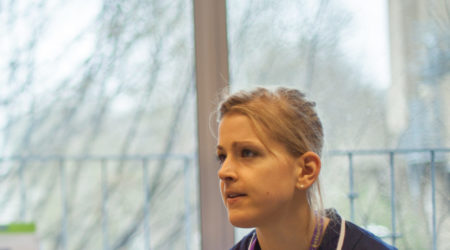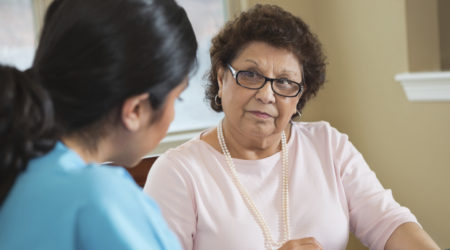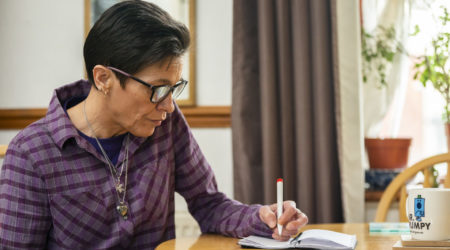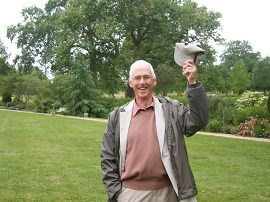
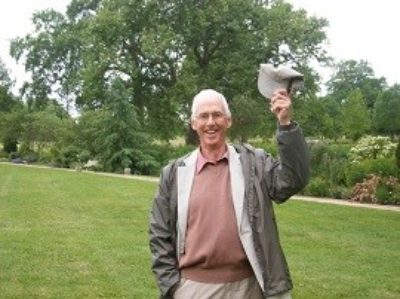
Cliff
Cliff was 67 when he was diagnosed with operable adenocarcinoma in the head of the pancreas.
Cliff updated his story in August 2017.
On July 16th 2009, I was told I had what the late Patrick Swayze’s autobiography, called “the most lethal and untreatable cancer there is”. For him that’s what it was and every day in the UK, some twenty-one people are diagnosed with this horrible disease and only one will be alive in five years.
Starting in January 2009, I suffered four bouts of slight illness each lasting about 48 hours no more than a dull ache across the top of my stomach, slight nausea and short feverish spells. I put it down to a ‘tummy bug’ and later episodes occurred during weekends away so a visit to my GP wasn’t convenient. Only in May did I arrange to see my doctor but as I felt well on the day, the doctor could only ask me to go back during, not after, the next bout. No appointment needed, I was told. Driving back from France in June, the symptoms came back and I went straight to my GP who kindly saw me ‘after hours’ and after an immediate blood test an ultrasound scan was booked.
Finding out my diagnosis
The NHS was to serve me well. Other than the 4-week wait for the Ultrasound scan, things moved very quickly. Only four days later, my consultant surgeon at carried out an endoscopy which identified a blockage in my bile duct caused by a growth in my pancreas. The stent he fitted was effective but was only a temporary measure. The growth was of more concern. A biopsy was taken for examination and a CT scan followed the same week.
Within days, Naida, my wife, and I sat with my consultant to hear the news we expected; I had cancer and it was in my pancreas. I had read of the usual prognosis and was prepared for the worst but there was some (almost) good news. The cancer was in the head of the pancreas and I was one of the lucky 15-20% for whom the Whipple’s Procedure was possible. He explained it, with diagrams, as a 6-8 hour operation which removed part of the pancreas plus the gallbladder, bile duct, duodenum and part of the stomach. He explained the procedure, risks and possible complications and I was booked for surgery on July 29th.
Focussing on the positives
It might seem odd but the operation wasn’t the only positive aspect of the consultation. From a bit of ‘googling’ I already knew that my consultant was, like me, a runner, and had run to raise charity funds for research into pancreatic cancer. I made a promise that if he “got me right”, my next run would be for the same charity. Surely, no disease is more destructive and under-funded than pancreatic cancer. It gave me a worthy, and I hoped, realistic goal for recovery. So it proved to be.
Until 2009 I was a happy, lucky 67-year-old man, with a lovely family of a wife, two children and three granddaughters, enjoying part-time work, cricket, reading, golf and French holidays. I had hardly had a day’s illness, in my life and had never smoked, drank very little, watched my weight and always kept fit by running. Now everything was to change, for a while at least. It was up to the medics and to me to make it as short an interruption as possible.
My operation
I heard later that the operation had involved a team of about ten led by my consultant, had started around 10.30, and by 5.30pm he had kindly phoned Naida to reassure her that everything had gone according to plan and although sample nodes were to be tested, his impression was that they ‘looked’ OK. When the results came through, his initial view was correct. There was no evidence that the cancer had spread.
I had surprisingly little pain save for the day that I cut down on pain-killers and the epidural was found not to be working. However, I pressed so hard for a discharge that I was allowed home after six days, too quickly for my own good and a slight infection in the wound became a serious infection and I was quickly back in hospital for a further five days. The second release was more successful.
Going home after surgery
Back home again, I made slow but steady progress. For a couple of weeks the district nurse came daily to replace my wound dressing, but iron tablets to address a low blood count were soon abandoned. My appetite was very slow to return to normal but I was encouraged to eat whatever I fancied. A diet of biscuits, cakes and chocolate wasn’t healthy but it served its purpose and as my appetite returned, I very gradually put back the 30lbs I had lost, aided by the enzyme supplements prescribed to help out the half of my pancreas that I have left. They are a life-long addition to every meal or snack but have no unpleasant side-effects.
Building up my strength
I built up fitness by walking a little further each day. More adventurously, and when nobody was looking, I carefully tried a few gentle running steps each day. I intended to be ready when I got the ‘official’ go-ahead to resume running. I got it from my consultant just ten weeks after surgery and started the next day. I resumed golf around the same time.
Getting back to normal and joining a clinical trial
Now, 18 months after surgery, I am virtually back to my previous health, again enjoying part-time work and all the same things as before. I suffer slight, occasional bloating after meals or heartburn before bedtime, rather loud rumblings from the stomach when I get hungry, and another minor digestive consequence, which we don’t discuss in polite company. Medically, I was told I didn’t need chemo but was invited on to a trial to compare the progress of patients who have chemo with those who don’t. I thought I was lucky to be in the latter group, though I do wonder if chemo as a kind of ‘belt and braces’ to recovery might have been a good idea. The trials do mean that I have had 3-monthly, now 6-monthly checks and scans so that any return of the cancer should be spotted quickly.
All in all, life is great, fully appreciated and enjoyed, and the next running target is in April with summer holidays and cricket to look forward to. From what I’ve heard and read I know how very lucky I am to survive pancreatic cancer’s first assault but also know that none of us, particularly me, have really beaten cancer until they live long enough to die of something else.
There can be life, and good life, after a Whipple’s, if you have a brilliant surgeon, good nurses and doctors, and a caring family. I will be eternally grateful to them all. Good luck is also necessary, and perhaps, too, a bit of effort and determination on your part helps.
Published February 2011
Update July 2015
Becoming a great-grandfather
It is now almost six years since my Whipples operation. I am delighted, and lucky, to say that my story goes on as well as my earlier story tells. I am just about to turn 72, continue to work (part-time), and run, play, travel and enjoy life as much as ever and I’m happy to report than my wife and I have now welcomed our first great-grandchild into the world. I try to remain on-guard in case my cancer returns but that helps me to appreciate more fully what the best things in life really are, and, yes, they are free.
Update August 2017
Enjoying life more than ever
It’s now eight years since my diagnosis and surgery and all still goes well. Only months after my operation I met a 9-year survivor and his good health gave me encouragement that a full recovery was really possible for me as well. I can do everything I used to do and I enjoy it all more than ever. Now 75 years old, I still work part-time, jog slowly and my wife and I can enjoy being three-time great-grandparents, something we would have doubted eight years ago. A bit of luck and maybe a bit of effort can work wonders.
